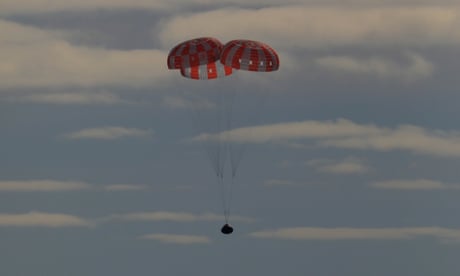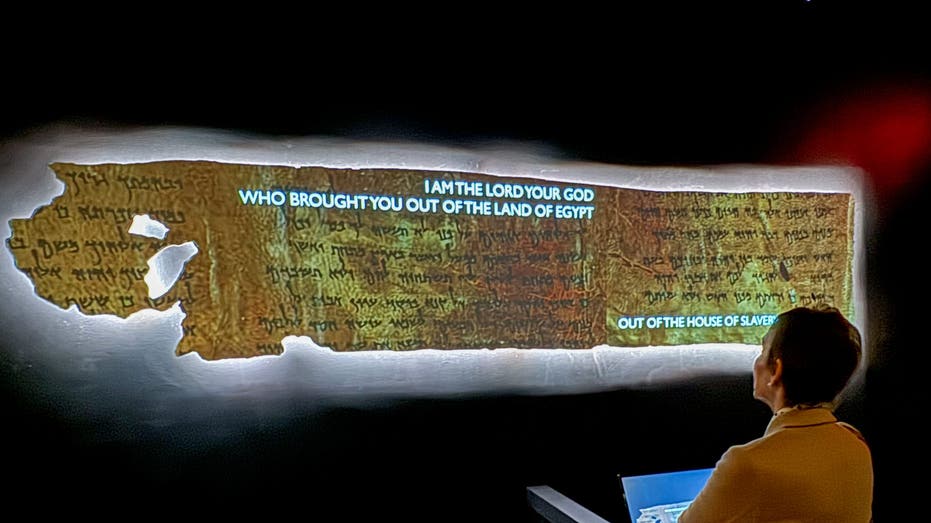- by foxnews
- 07 Apr 2025
Nasa’s uncrewed Orion capsule splashes down after ‘historic’ moon mission
Nasa’s uncrewed Orion capsule splashes down after ‘historic’ moon mission
- by theguardian
- 12 Dec 2022
- in news

Fifty years to the day after astronauts last walked on the moon, Nasa's uncrewed Orion capsule splashed down in the Pacific on Sunday at the end of a mission that should clear the way for a possible lunar landing of astronauts by 2025.
The US space agency rejoiced in a near-perfect re-entry of the capsule which splashed down to the west of Mexico's Baja California near Guadalupe Island. Though it carried no astronauts, the spacecraft did contain three test dummies wired with vibration sensors and radiation monitors to divine how humans would have fared.
"Splashdown!" the Mission Control commentator Rob Navias announced. "From Tranquility Base to Taurus-Littrow to the tranquil waters of the Pacific, the latest chapter of Nasa's journey to the moon comes to a close. Orion back on Earth."
Orion's return brings to a completion the first flight of Artemis I, Nasa's new moon program which has been devised as the follow-on to the Apollo era. Its aim is to return astronauts to the surface of the moon this decade, and then to create a base there from which to launch explorations of Mars.
On 11 December 1972, two astronauts aboard Apollo 17 - Eugene Cernan and Harrison Schmitt - became the last of 12 moonwalkers. They had spent three days in the valley of Taurus-Littrow in the longest moon landing of the Apollo era.
Nasa's mission control complex in Houston declared Sunday to be an extraordinary day. "I'm overwhelmed," Nasa's administrator Bill Nelson told Associated Press. "It's historic because we are now going back into deep space with a new generation."
The success of the first Artemis flight paves the way to further moon missions in quick order. Nasa plans an Artemis II flight around the moon and back with astronauts on board perhaps by 2024, with the first human lunar landing to follow with Artemis III potentially the year after.
Nasa scientists were especially relieved by the successful return of the Orion capsule given the troubled beginnings of Artemis. Delays and cost overruns have bedeviled the program, with storms and fuel leaks forcing launches to be postponed through the summer and autumn.
Orion blasted off on 16 November from the Kennedy Space Center in Florida's Cape Canaveral. In the course of its 25-day, $4bn flight, Orion spanned 1.4m miles (2.25m km) and came within 80 miles (130km) of the moon during a week-long orbit.
Nasa was keen to test out the reliability of its new heat shield that was deployed in the last 20 minutes of flight as a means of coping with temperatures of almost 2,760C(5,000F) generated with re-entry into the Earth's atmosphere. It did so at speeds of up to 24,500mph, with atmospheric friction being used to slow the capsule to about 325mph before parachutes were engaged ensuring a dignified splashdown.
The mission's architects also tested out a maneuver known as "skip-entry" - the first time it had been practiced with a capsule built for astronauts. The method involves the spacecraft bouncing off the atmosphere and then dipping in again, as a way both to reduce the force of gravity and to allow a more precise targeting of the landing site.
- by foxnews
- descember 09, 2016
Ancient Ten Commandments fragment of 2,000-year-old manuscript to go on display at Reagan Library
The "Dead Sea Scrolls" exhibit, announced at the Ronald Reagan Presidential Library and Museum, features ancient Jewish manuscripts, plus the rarely seen Ten Commandments Scroll.
read more


